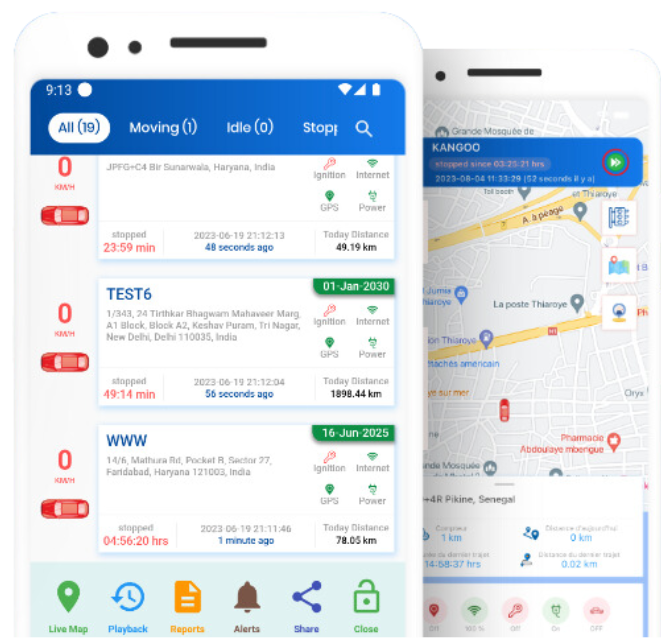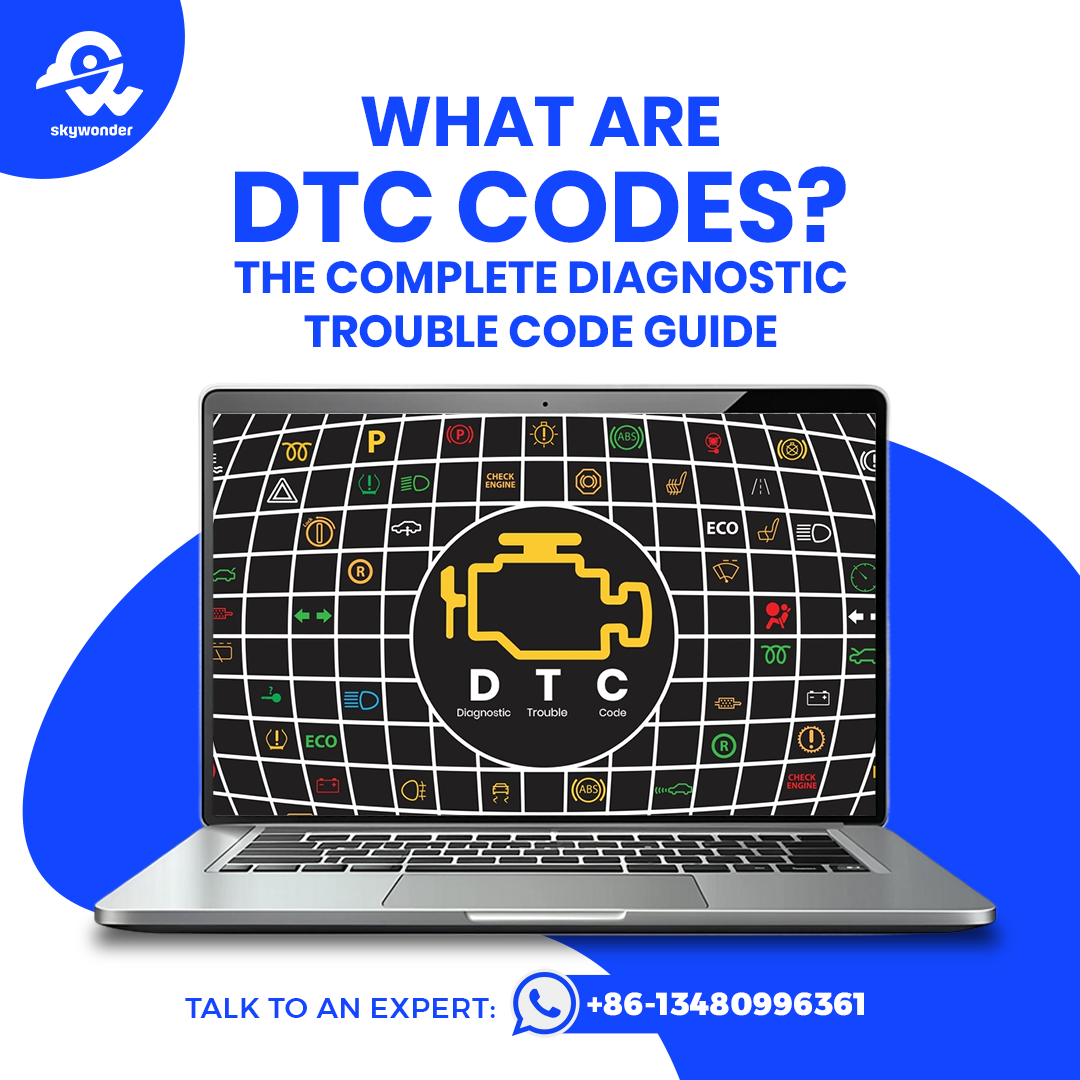What are DTC Codes? The Complete Diagnostic Trouble Code Guide
As the key member of Skywonder Technology Company Limited, I’ve spent over a decade in the GPS tracking and fleet management industry. Over the years, I’ve seen how diagnostic tools have changed the way vehicles are taken care of. One important tool for keeping vehicles running well is DTCs—Diagnostic Trouble Codes. These DTC codes are important for looking after a fleet, making sure vehicles work properly, and reducing time spent fixing them. In this guide, I’ll explain everything about DTCs, especially how they connect to GPS tracking systems and fleet management, with our OBD2 GPS Tracker playing a key role in this process.
What is a DTC Codes?
DTC, or Diagnostic Trouble Code, is a message from a car’s computer that tells you when something isn’t working right. When the car’s system finds a problem, it creates a DTC and usually turns on the “check engine” light.
For us at Skywonder, understanding and using DTCs in our GPS tracking and fleet management software is important. With our C30 OBD2 GPS Tracker, fleet managers can easily connect to the car’s OBD-II port, which helps them track vehicles and monitor diagnostic issues in real time. This feature has been especially helpful for our clients in places like Saudi Arabia, Kenya, and Brazil, where fixing vehicles can be expensive, and any downtime can slow down work.
The Structure of DTC Codes
DTC codes are five characters long, and each character tells us something about the problem. Let’s break it down:
- First Character (Letter):
- P for Powertrain: These are the most common codes and relate to the engine, transmission, or drivetrain.
- C for Chassis: Covers issues with the steering, suspension, or brakes.
- B for Body: Refers to problems inside the car, like airbags or seat belts.
- U for Network: Deals with how the car’s systems communicate.
- Second Character (Number):
- 0: A code that applies to all cars.
- 1: A code specific to one car manufacturer.
- Third Character (Subsystem): This character tells us which part of the car has the issue. For example, “0” refers to the fuel and air system, while “7” shows there is a transmission issue.
- Fourth and Fifth Characters: These characters describe the exact problem in more detail.
For example, P0462 means:
- P: Powertrain (engine, transmission, or drivetrain)
- 0: Applies to all cars
- 4: Emission controls (system that controls pollutants)
- 62: Fuel level sensor problem
Using our C30 OBD2 GPS Tracker, these codes are sent directly to our tracking platform, TraqCare, where fleet managers can act quickly to fix the problem before it gets worse.
Get Expert Tips to Resolve Diagnostic Trouble Codes Today!
Prompts the reader to explore expert advice on resolving DTCs.
Ask For Demo →
Common DTC Codes and Their Fixes
Some DTC codes are more common than others, and knowing how to fix them can save both time and money. Here are a few examples:
- P0300: Cylinder misfire detected. This means the engine isn’t working right, often due to problems with the spark plugs or ignition system. Replacing these parts usually fixes the issue.
- P0171: System too lean. This could mean the car is getting too much air or not enough fuel. Fixing it might involve replacing the oxygen sensor or fixing a leak.
- P0420: Problem with the catalytic converter. This part helps reduce pollution from the car. If it fails, it often needs to be replaced.
By using our C30 OBD2 GPS Tracker connected to the OBD-II port, these DTCs are related in real time to the TraqCare platform. Fleet managers can get instant notifications when a DTC appears, allowing them to take care of the issue before it leads to more significant problems.
If you can read more about the OBD-II PIDs (On-board diagnostics Parameter IDs), by visiting the wikipedia page.
The Role of OBD-II Devices in Fleet Management
OBD-II devices, like our C30 OBD2 GPS Tracker, play an essential role in modern vehicle diagnostics. Since 1996, most cars have been equipped with OBD-II ports that make it easy to access data on vehicle performance. At Skywonder, we’ve seen how connecting GPS trackers to the OBD-II port provides powerful tools for fleet management.
By plugging the C30 OBD2 GPS Tracker into the OBD-II port, we can track not only the vehicle’s location but also its performance, helping fleet managers monitor DTCs, fuel use, and even driver behavior. For example, if a vehicle shows a P0700 code (a transmission issue), the fleet manager is immediately notified and can schedule repairs before the problem worsens.
What is DTC Severity?
Not all DTC codes are the same. Some need to be fixed right away, while others are less urgent. Understanding how severe a DTC code is helps fleet managers decide when to take action:
- Severity 1: Small issues that don’t affect the car too much but should still be watched.
- Severity 2: Issues that need to be fixed soon because they could lead to bigger problems. For example, P0462 (fuel level sensor issue) is a severity 2 problem, because wrong fuel readings can lead to wasted fuel or other issues.
- Severity 3: Serious problems that need to be fixed right away, such as P0650 (problem with the check engine light control). Ignoring these can lead to safety problems.
The C30 OBD2 GPS Tracker makes it easier for fleet managers to track these issues. They can monitor the severity of the codes and make quick decisions about whether a repair can wait or needs to be done immediately.
Common DTC Codes Related to Transmission Issues
Transmission problems can be a big headache for fleet managers because they often lead to long repairs and high costs. Some common transmission-related DTC codes include:
- P0700: Transmission Control System Malfunction. This is a general code for transmission issues and could mean there’s a sensor problem or something more serious.
- P0730: Incorrect Gear Ratio. This code means the transmission isn’t shifting gears correctly. It might be caused by worn-out parts or a faulty sensor.
- P0741: Torque Converter Clutch Problem. This means the car’s fuel efficiency is lower than normal, which could cause the engine to overheat.
By using C30 OBD2 GPS Tracker, fleet managers can keep track of these codes and schedule repairs before the issues become costly. For example, if a P0700 code is detected, our system alerts the fleet manager so that action can be taken right away.
Unlock Your Car’s Secrets: Diagnose DTC Codes with Ease!
Invites readers to take control of their vehicle diagnostics with ease.
Ask For Demo →
Conclusion
DTC codes are an important tool for fleet managers because they provide valuable information about a vehicle’s condition. At Skywonder, we’ve seen how connecting DTC data with GPS tracking can help companies save money and keep their vehicles running well. Our C30 OBD2 GPS Tracker is a perfect example of how technology can make fleet management easier by giving real-time insights into both vehicle location and health.
Whether you’re managing a fleet in Saudi Arabia or Brazil, having real-time diagnostic data can make a big difference. If you want to learn more about how Skywonder’s OBD2 GPS Trackers and TraqCare platform can help improve your fleet’s performance, feel free to reach out.

